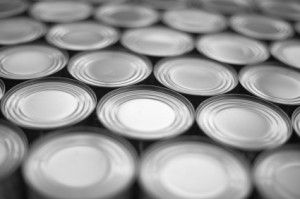I’ve been interested in food storage for about twenty-five years. My husband and I started our food storage as newlyweds. On our meager budget, we worked slowly to build the basic staples—wheat, oil, honey, and beans—followed by canned goods, baking supplies, and dried foods. Initially, I didn’t think too much about the containers I stored the food in. I bought powdered milk at the store and kept it in the original box. Ditto for a twenty-five pound bag of flour.
 I soon realized, though, that this is a foolish way to approach food storage. All the effort and money we spent on procuring food storage went right out the window when foods weren’t properly stored. The bag of flour I laid on our basement floor was lumpy because moisture had infiltrated it. I’ve also learned recently that chemicals in the cement can leach into bags stored this way. Mice had a party nibbling on my boxes of cereal, crackers, and powdered milk. Insect infestations were another common problem.
I soon realized, though, that this is a foolish way to approach food storage. All the effort and money we spent on procuring food storage went right out the window when foods weren’t properly stored. The bag of flour I laid on our basement floor was lumpy because moisture had infiltrated it. I’ve also learned recently that chemicals in the cement can leach into bags stored this way. Mice had a party nibbling on my boxes of cereal, crackers, and powdered milk. Insect infestations were another common problem.
In recent years, I’ve taken more of an interest in not only which foods to store, but how to store them. Read on for a discussion of the common food storage methods and their potential benefits and drawbacks.
Mason Jars
Mason jars were first invented in the late 1800s, and modern science hasn’t been able to improve them much. Used properly, they’re a great way to preserve fruits, vegetables, sauces, meats, and main dishes. But how about dried grains, legumes, and powdered milk? I store large amounts of dried beans and grains in my basement food storage room, but I keep smaller quantities in mason jars in my pantry for easy access.
Gallon or half-gallon size mason jars are harder to find, but they’re great for storing canned juice, as well as powdered milk, sugar, and brown sugar. They don’t give an off-flavor to food and they can be used over and over again. To use mason jars for storing dry goods, add an oxygen absorber packet (more about these later) to the top of the jar. Use new lids and heat them in simmering water to soften the rubber gasket. As the oxygen absorber draws oxygen from the air, it creates a vacuum effect and the jar seals partially or fully.
Mason jars are clear so they absorb light. Store them in a cool, dark location because light causes food to deteriorate. Don’t stack them, and keep them on a sturdy, protected shelf. You might even want to add a low board to the front of the shelf so jars can’t tip and break.
Survive the coming food shortage with these Food Storage Secrets!
#10 Cans
These large, sturdy cans are one of the best ways to store dry foods for long-term storage. They’re impervious to rodents, light, air, and moisture and are almost indestructible. They can be stacked, and since food is stored in small amounts, you only use what you need.
I’ve got cans of wheat that I’ve had for over twenty years—still perfectly fine. The two downsides to using cans are the potential for off-tastes to develop and the cost of the sealing equipment. Many years ago, I canned flour in cans. When I used the flour, it had a slightly tinny taste that didn’t go away. I haven’t noticed this problem with beans, wheat, or sugar, but it’s something to think about.
The cost of the sealing equipment for these cans is prohibitive for most families, but here’s a thought: why not go in with like-minded families or your church group and buy the equipment to share? Another option is to visit LDS Home Storage Centers. Owned and operated by the LDS Church, these centers have all the equipment you need. You don’t have to be a member of the LDS church to use the equipment, but you must schedule your visit ahead of time. The centers don’t take credit cards, so bring a check and make sure you clean up after yourself. You can also buy bulk goods like dried beans, sugar, and wheat here for very reasonable prices.
Food-Safe Buckets
I love food-safe buckets for storing food that I know I’ll use within six months to one year. They’re stackable and easy to access, and they keep moisture and rodents out so food stays safe. Use them for storing staples like flour, sugar, pasta, rice and oats.
Lots of online preparedness stores sell food-grade buckets, but my local bakery gives them away for free. These buckets previously contained icing, so I wash them out really well with lots of soapy water. I don’t want the oils in the icing to remain in the bucket since they can cause foods to go rancid. These buckets have easy-to-seal lids, but you can also order lids online.
Use only buckets labeled for food use though. Those cheap buckets at Home Depot won’t do. They may have dyes or chemicals in them that make them unsafe. Additionally, once you’ve used a bucket for paint or other chemicals, don’t store food in it. The plastic is porous, and small amounts of chemicals remain even after you’ve washed the bucket.
If you want to use food-safe buckets to store food for longer than a few months, put the food in a Mylar bag inside the bucket. Seal the Mylar bag and lay an oxygen absorber packet on top of the sealed bag. Close the lid tightly. As the O2 absorber draws the oxygen out of the bucket, the lid compresses slightly to seal.
Mylar Bags
Many people use Mylar bags alone for storage, but I prefer to use them inside a food-safe bucket. The Mylar bags keep food dry and fresh, but they’re easily punctured or damaged by rodents. Think of them as extra insurance when you’re storing food long-term in a plastic bucket. Mylar bags are also a good option for storing food in the freezer.
Oxygen Absorbers and Desiccants
You may have seen oxygen absorber and desiccant packets promoted on the Internet, but it’s important to know the difference between these two. Desiccants usually contain some form of silica, which draws moisture out of food to prevent decay and mold. They work reasonably well in number-ten cans, but you’d have to use an awfully lot of them to remove moisture from a large bucket of food.
For most purposes, oxygen absorbers are more efficient at preserving food quality. These packets contain iron powder, which oxidizes when exposed to air. These packets got hot as they’re working and actually create a vacuum seal when used in Mason jars or sealed buckets by removing the oxygen from the container.
Final Notes
So, which preservation method should you choose? I prefer a combination of all of the above-described methods. I keep staples close at hand in mason jars. I store wheat, beans, rice, and sugar for long-term use in #10 cans. And, I store large amounts of foods that I know I’ll use soon in plastic buckets. This versatility works well for my cooking habits and ensures that if one method fails, I’ll have a backup plan.
©2012 Off the Grid News
 Off The Grid News Better Ideas For Off The Grid Living
Off The Grid News Better Ideas For Off The Grid Living




